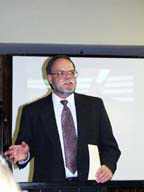Representatives of the New Jersey and New York Department of Agriculture were at Hoboken City Hall Monday night to discuss the infestation of the wretched Asian Long Horned Beetle in Jersey City.
According to Carl P. Schulze Jr., acting director of the Division of Plant Industry of the N. J. Department of Agriculture, the pests have been found at a nine-acre site in the Newport area of New Jersey, where 102 infested trees have been discovered.
"We have not found any [Long Horned] Beetles in Hoboken and we hope that we do not find any in Hoboken," said Schulze Monday.
Despite the fact that no beetles have been found in Hoboken, the city’s close proximity to the infected Newport area has prompted state officials to declare much of Hoboken a quarantine zone to prevent the spread of the beetle, according to Schulze. This includes most of Hoboken, from the southern border to 11th Street. The quarantine restricts the movement of firewood, green lumber, and other living, dead, cut or fallen material, including nursery stock, logs stumps, roots and branches from potential host trees. Movement of these materials from the quarantine area is prohibited.
Why so dangerous?
According to the U.S. Department of Agriculture, the ALB has earned the title of pest here and in its home country, China. The beetle is a serious threat to hardwood trees and has no known natural predator in the United States. ALB beetles are about one to 1.5 inches long, are shiny and black with white spots, and have long antennae that are banded with black and white. They attack many hardwood trees including maple, birch, horsechestnut, willow, elm, ash, and black locust. Individual beetles typically attack a single host tree but then migrate to a nearby host tree when the population becomes too dense.
Because the beetle spends most of its life cycle deep inside the host tree, most pesticides are ineffective. At present, the only effective method of eliminating the beetle is to cut, chip, or burn infested trees and replace them with nonhost species.
Schulze added that if the bug became established in the United States, it has the potential to cause more damage that Dutch elm disease, chestnut blight, and gypsy moth combined, destroying millions of acres of hardwood trees in national forests as well as people’s back yards.
Barry Emens, a supervisor for the Southern New Jersey Region of the U.S. Department of Agriculture, said that possible impact of the ALB should not be taken lightly. "It’s a very dangerous insect to our forest industry," he said Monday. "There are a lot of eyes across the country looking at us here in Jersey City to make sure these pests are eliminated."
He added that since 1996, the bugs have been found in Greenpoint, Brooklyn, Central Park, and in one suburb of Chicago, all of which are well on the way to being controlled.
According to Schulez, the infected trees in Jersey City will be cut down and removed within the next couple of weeks. He said that because the insects are dormant in the winter months, the pests do not present a biological threat during the winter. Because the ALBs are dormant, it gives scientists and researchers the opportunity to gather data for a couple more weeks until the trees are removed and then destroyed by chipping or burning.
How to recognize the beetles?
Emens said Monday that early detection of infestations is crucial to successful eradication of the beetle. He added that surveys of potential host trees within a half mile radius of the site are nearing completion. Tree climbers started inspecting potential host trees in residential sections of Jersey just before Thanksgiving, and expect to expand their inspections into Hoboken neighborhoods by mid-December.
Emens said that to be successful, there has to be cooperation with the community. He has asked property owners to provide inspectors access to their yards and trees so the extent of the infestation can be determined.
He also asks residents to keep their eyes open for the pest. He added that the bugs in Jersey City were first reported by a Hoboken resident who was helping a friend move. The man had taken several agriculture classes in college and alerted the Department of Agriculture.
How to recognize the infestation
According to Emens, there are several ways to recognize an infestation. Adult beetles are three quarters to one and quarter inches long, with a jet black body and mottled white spots on the back. The long antennae are one and half to two and a half times the body length with distinctive black and white bands on each segment.
Residents can also look at the tree for remnants of the beetles. When digging out of the trees, the adult beetles create perfectly symmetrical three-eighths-of-an-inch-in-diameter exit holes on the trunk and on the branches.
Another sign of the bugs are oval round pits in the bark. These are the egg-laying sites or notches which are chewed out by the female beetle to lay their eggs.
Also, if there is an accumulation of coarse sawdust around the base of the trees, where the branches meet the main stem and where branches meet other branches, there is a possibility that the tree is infested. This sawdust is created by the beetle larvae as they bore into the main tree stem and branches.
If there is any evidence of the ALB, call (609) 984-3707, (609) 259-8650 or visit www.aphis.usda.gov.
